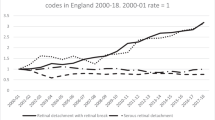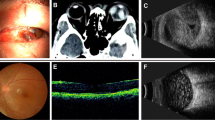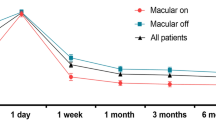Learning Objectives
Upon completion of this activity, participants will be able to:
- 1.
Describe symptomatic improvement after PPV for symptomatic floaters, according to results from a retrospective survey study.
- 2.
Determine safety outcomes after PPV for symptomatic floaters, according to results from a retrospective survey study.
- 3.
Identify clinical implications of the efficacy and safety of PPV for symptomatic floaters, according to results from a retrospective survey study.
Accreditation statements
In support of improving patient care, this activity has been planned and implemented by Medscape, LLC and Springer Nature. Medscape, LLC is jointly accredited by the Accreditation Council for Continuing Medical Education (ACCME), the Accreditation Council for Pharmacy Education (ACPE), and the American Nurses Credentialing Center (ANCC), to provide continuing education for the healthcare team.
Credit hours
1.0
Release date:
Expiration date: 19 April 2020
Post-test link:
https://medscape.org/eye/posttest924758

Authors/Editors disclosure information
Sobha Sivaprasad, MD, has disclosed the following relevant financial relationships: Served as an advisor or consultant for: Allergan, Inc.; Bayer AG; Boehringer Ingelheim Pharmaceuticals, Inc.; Heidelberg Pharma GmbH; Optos; Roche. Served as a speaker or a member of a speakers bureau for: Allergan, Inc.; Bayer AG; Novartis Pharmaceuticals Corporation; Optos. Received grants for clinical research from: Allergan, Inc.; Bayer AG; Boehringer Ingelheim Pharmaceuticals, Inc.; Novartis Pharmaceuticals Corporation; Optos. EOZ, MD, has disclosed no relevant financial relationships. BP, MD, has disclosed no relevant financial relationships. SO, MD, has disclosed no relevant financial relationships. SB, MD, has disclosed the following relevant financial relationships: served as a speaker or a member of a speakers bureau for: Allergan, Inc.; Bayer AG; Novartis Pharmaceuticals Corporation. RAA, MD, MPH, has disclosed no relevant financial relationships. FK, MD, has disclosed no relevant financial relationships. GG, MD, has disclosed no relevant financial relationships. AS, MD, has disclosed no relevant financial relationships. NA, MD, has disclosed no relevant financial relationships.
Journal CME author disclosure information
Laurie Barclay, MD, Freelance writer and reviewer, Medscape, LLC, and has disclosed no relevant financial relationships.
Abstract
Background/objectives
To evaluate the efficacy and safety of pars plana vitrectomy for symptomatic floaters.
Subjects/methods
Forty-eight vitreoretinal surgeons from 16 countries provided information on 581 eyes who underwent vitrectomy for floaters in this retrospective survey study conducted by European VitreoRetinal Society. Percentage symptomatic improvement, incidence of retinal tears/detachment and post-vitrectomy cataract surgery, and the factors associated with satisfaction and complications were investigated.
Results
Ninety-two percent were satisfied with the results, with 86.3% reporting complete resolution of daily-life symptoms. Overall satisfaction was lower in patients with smaller vitreous opacities at presentation (OR:0.4). Iatrogenic retinal breaks occurred in 29 eyes (5%). Core vitrectomy and cut rates of 1500–4000 or >4000 cuts/min were associated with lower risk of retinal breaks than complete vitrectomy (OR:0.05) and cut rates < 1500 cuts/min (OR: 0.03, 0.12, respectively). Fourteen eyes (2.4%) developed retinal detachment at a median of 3 months; and 84 (48.6%) developed cataract at a median of 16 months post-vitrectomy.
Conclusions
Pars plana vitrectomy resulted in high patient satisfaction with relatively low rate of severe complications in a large group of patients. The procedure may be safer when core vitrectomy and cut rates > 1500 cuts/min are favoured. Proper patient selection and informed consent are the most important aspects of surgery.
Similar content being viewed by others
Log in or create a free account to read this content
Gain free access to this article, as well as selected content from this journal and more on nature.com
or
References
Tozer K, Johnson M, Sebag J. Vitreous aging and posterior vitreous detachment. In: Sebag J, editors. Vitreous—in health and disease. New York: Springer-Verlag; 2014. p. 131–50.
Gale J, Ikuno Y. Myopic vitreopathy. In: Sebag J, editors. Vitreous—in health and disease. New York: Springer-Verlag; 2014. p. 113–29.
Roufail ED, Polkinghorne P. Vitreous floaters. Compr Ophthalmol Update. 2006;7:171–7.
Henry CR, Smiddy WE, Flynn HW Jr. Pars plana vitrectomy for vitreous floaters: is there such a thing as minimally invasive vitreoretinal surgery? Retina. 2014;34:1043–5.
Wagle AM, Lim WY, Yap TP, Neelam K, Au Eong KG. Utility values associated with vitreous floaters. Am J Ophthalmol. 2011;152:60–5 e1.
de Nie KF, Crama N, Tilanus MA, Klevering BJ, Boon CJ. Pars plana vitrectomy for disturbing primary vitreous floaters: clinical outcome and patient satisfaction. Graefes Arch Clin Exp Ophthalmol. 2013;251:1373–82.
Zou H, Liu H, Xu X, Zhang X. The impact of persistent visually disabling vitreous floaters on health status utility values. Qual Life Res. 2013;22:1507–14.
Delaney YM, Oyinloye A, Benjamin L. Nd:YAG vitreolysis and pars plana vitrectomy: surgical treatment for vitreous floaters. Eye (Lond). 2002;16:21–6.
Tan HS, Mura M, Lesnik Oberstein SY, Bijl HM. Safety of vitrectomy for floaters. Am J Ophthalmol. 2011;151:995–8.
Schulz-Key S, Carlsson JO, Crafoord S. Longterm follow-up of pars plana vitrectomy for vitreous floaters: complications, outcomes and patient satisfaction. Acta Ophthalmol. 2011;89:159–65.
Tsai WF, Chen YC, Su CY. Treatment of vitreous floaters with neodymium YAG laser. Br J Ophthalmol. 1993;77:485–8.
Little HL, Jack RL. Q switched neodymium: YAG laser surgery of the vitreous. Graefes Arch Clin Exp Ophthalmol. 1986;224:240–6.
Moore JK, Kitchens JW, Smiddy WE, Mavrofrides EC, Gregorio G. Retinal breaks observed during pars plana vitrectomy. Am J Ophthalmol. 2007;144:32–6.
Covert DJ, Henry CR, Bhatia SK, Croskrey J, Sanchez CR, Han DP. Intraoperative retinal tear formation and postoperative rhegmatogenous retinal detachment in transconjunctival cannulated vitrectomy systems compared with the standard 20-gauge system. Arch Ophthalmol. 2012;130:186–9.
Tan HS, Mura M, de Smet MD. Iatrogenic retinal breaks in 25-gauge macular surgery. Am J Ophthalmol. 2009;148:427–30.
Hikichi T, Kosaka S, Takami K, et al. Incidence of retinal breaks in eyes undergoing 23-gauge or 20-gauge vitrectomy with induction of posterior vitreous detachment. Retina. 2012;32:1100–5.
Mura M, Barca F, Dell'Omo R, Nasini F, Peiretti E. Iatrogenic retinal breaks in ultrahigh-speed 25-gauge vitrectomy: a prospective study of elective cases. Br J Ophthalmol. 2016;100:1383–7.
Rizzo S, Genovesi-Ebert F, Belting C. Comparative study between a standard 25-gauge vitrectomy system and a new ultrahigh-speed 25-gauge system with duty cycle control in the treatment of various vitreoretinal diseases. Retina. 2011;31:2007–13.
Sebag J, Yee KM, Wa CA, Huang LC, Sadun AA. Vitrectomy for floaters: prospective efficacy analyses and retrospective safety profile. Retina. 2014;34:1062–8.
Mason JO, Neimkin MG. Safety, efficacy, and quality of life following sutureless vitrectomy for symptomatic vitreous floaters. Retina. 2014;34:1055–61.
Ling CA, Weiter JJ, Buzney SM, Lashkari K. Competing theories of cataractogenesis after pars plana vitrectomy and the nutrient theory of cataractogenesis: a function of altered aqueous fluid dynamics. Int Ophthalmol Clin. 2005;45:173–98.
Cheng L, Azen SP, El-Bradey MH, et al. Duration of vitrectomy and postoperative cataract in the vitrectomy for macular hole study. Am J Ophthalmol. 2001;132:881–7.
Schiff WM, Chang S, Mandava N, Barile GR. Pars plana vitrectomy for persistent, visually significant vitreous opacities. Retina. 2000;20:591–6.
Kim YK, Moon SY, Yim KM, Seong SJ, Hwang JY, Park SP. Psychological distress in patients with symptomatic vitreous floaters. J Ophthalmol. 2017;2017:3191576.
Cipolletta S, Beccarello A, Galan A. A psychological perspective of eye floaters. Qual Health Res. 2012;22:1547–58.
Mura M, Engelbrecht LA, de Smet MD, Papadaki TG, van den Berg TJ, Tan HS. Surgery for floaters. Ophthalmology. 2011;118:1894–e1.
Shah CP, Heier JS. YAG laser vitreolysis vs sham YAG vitreolysis for symptomatic vitreous floaters: a randomized clinical trial. JAMA Ophthalmol. 2017;135:918–23.
Author information
Authors and Affiliations
Consortia
Corresponding author
Ethics declarations
Conflict of interest
The authors declare that they have no conflict of interest.
Additional information
Publisher’s note Springer Nature remains neutral with regard to jurisdictional claims in published maps and institutional affiliations.
Members of the EVRS Floaters Study Group are listed at the end of paper.
Supplementary information
Rights and permissions
About this article
Cite this article
Zeydanli, E.O., Parolini, B., Ozdek, S. et al. Management of vitreous floaters: an international survey the European VitreoRetinal Society Floaters study report. Eye 34, 825–834 (2020). https://doi.org/10.1038/s41433-020-0825-0
Received:
Accepted:
Published:
Issue date:
DOI: https://doi.org/10.1038/s41433-020-0825-0
This article is cited by
-
The impact of vitreous floaters on quality of life: a qualitative study
Journal of Patient-Reported Outcomes (2025)
-
Outcomes of pars plana vitrectomy for visually significant floaters in Northern Alberta
International Journal of Retina and Vitreous (2025)
-
Efficacy and Safety of Pars Plana Vitrectomy for Primary Symptomatic Floaters: A Systematic Review with Meta-Analyses
Ophthalmology and Therapy (2022)



